Hi everyone! This is Part One of my Insect Mating Pair Series. I will post a new insect each Monday for the next 8 weeks, saving the best for last.
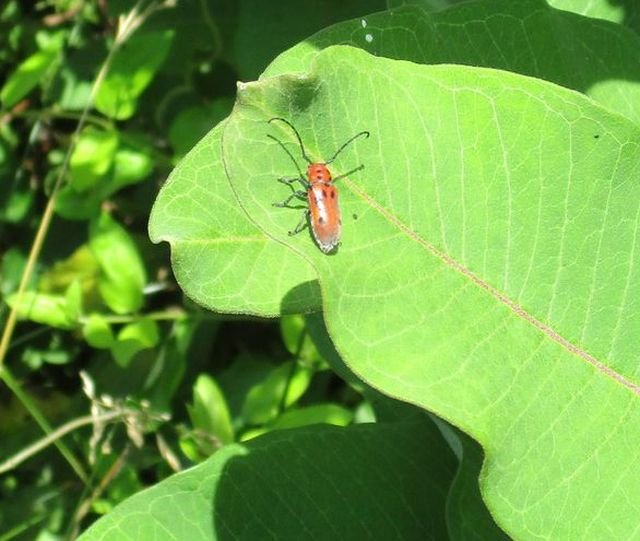
There are different insects that can be found on all different milkweed plants. This Red Milkweed Beetle (Tetraopes tetrophthalmus) is one of those insects and it prefers this Common Milkweed plant (Asclepias syriaca). It is an eastern milkweed beetle in the Long-horned beetle family that I found here in Northeastern USA.
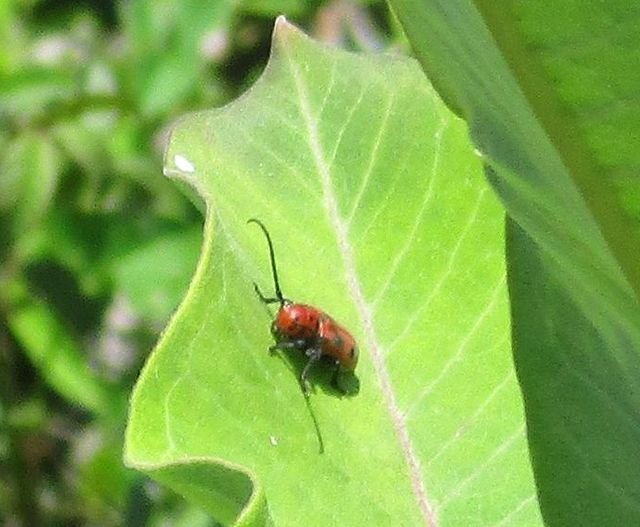
Adults can be found on these plants beginning in late spring when the buds appear. They are approximately 5/16 inches to 5/8 inches long and have a robust body. Their long black antennae are almost as long as their body. Their antennae have a red base that is inserted into their black eyes, splitting the eyes into two parts, and that is why they are sometimes called four-eyed beetles.

Milkweed plants are toxic and the red milkweed beetle is one of the few insects that can feed on these plants, because they store the toxins safely in their body. They sport the red and black colors which advertises their toxicity to their predators, telling them "I don't taste good."
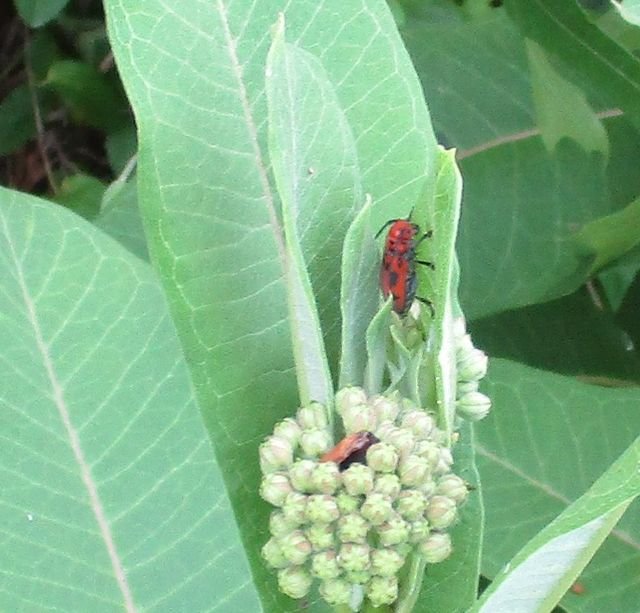
Adult red milkweed beetles eat the leaves, buds and flowers of this common milkweed plant. The plant contains a sticky latex substance and when a red milkweed beetle gets that substance on its mouthparts from feeding, they know to immediately clean their mouthparts by rubbing its face against the leaf, so its mouth won't get glued shut. Isn't that amazing?
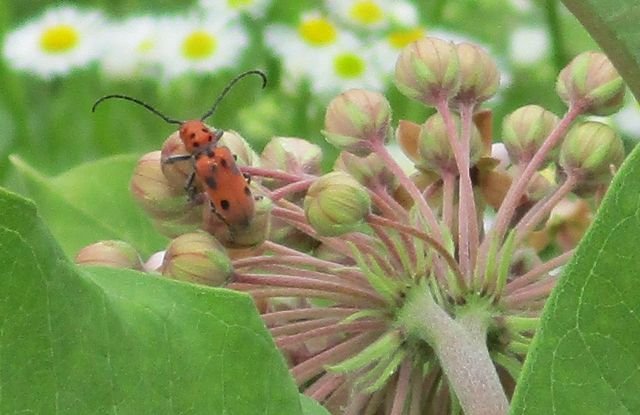
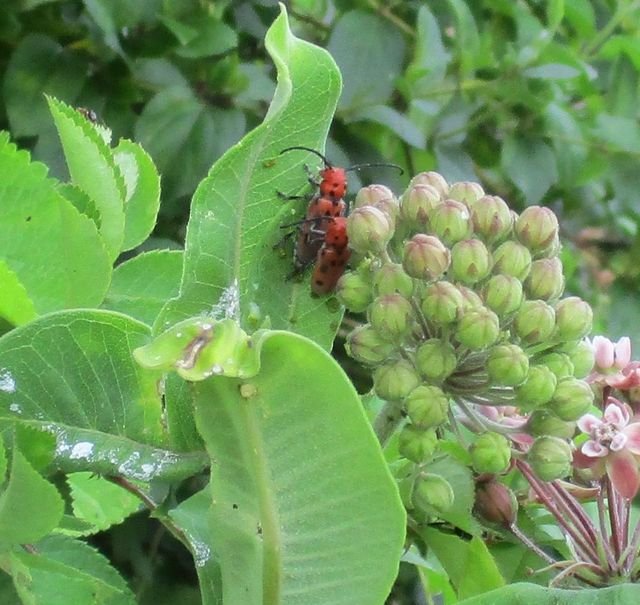
What do these red milkweed beetles do when it is time to mate? The female waits for the male to find her, and she doesn't give him any help because she doesn't send out pheromones. The male knows that if it flies to the milkweed plant, he will eventually find his mate.
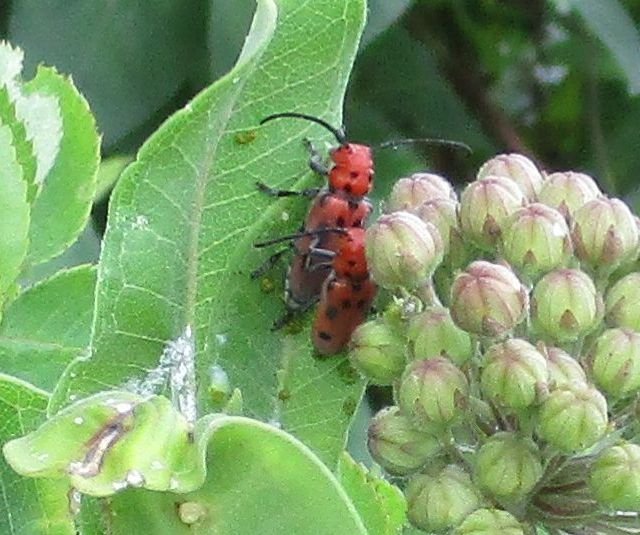
The female lays her eggs in early summer on the soil or just below the soil next to the milkweed stem. She may also deposit her eggs into the stem at times. The larvae are called grubs and after they hatch, they burrow down to find the roots of the milkweed plant and that is where they live and grow, while feeding on the roots. They overwinter underground and when they are full grown in the spring, they pupate. Adults emerge one month later.
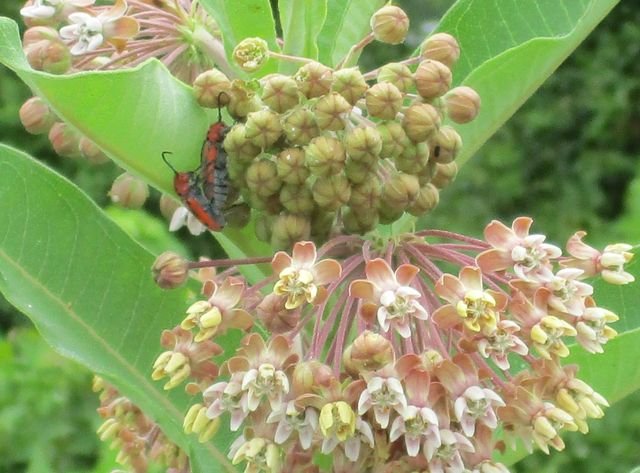
You all know that cats purr but did you ever hear of an insect that purrs? In 1957, a man by the name of Richard D. Alexander studied red milkweed beetles and he heard a "purring" sound when the beetles were alone, feeding or at rest. He also heard a "squeaking" sound when a lone beetle was scared or thought it was in danger. However, Alexander also heard purring and squeaking combined when two beetles meet and touch antennae, or crawl over each other. Isn't that amazing?
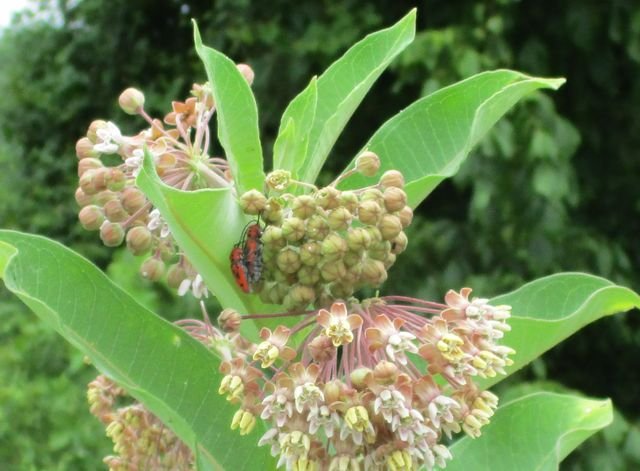
This is my entry for the Amazing Nature Contest created by @adalger. You can go here to find out how you can enter this amazing contest.
Information Source: uwm.edu, minnesotaseasons.com, thoughtco.com
Such a worthy article. I learned so much.
Beetles that squeak? Beetles that purr?
And the photos are brilliant.
Why don't you add a SteemSTEM tag to this post? It is so rich with information.
I have resteemed.
Looking forward to the follow up posts.
With respect, and admiration,
Your friend, AG
Thanks so much AG! I am excited and happy to know that you learned something from me. Thank you for always supporting and encouraging me, and thanks for resteeming. Hugs!
I just don't feel right using SteemSTEM as one of my tags. I feel like it makes me look like I am begging them. They have found me before without me using it. But I do appreciate you wanting to help. : )
Great photos and info on the milkweed plant. This plant is so important for the Monarch butterfly to feed on that it’s good to know how to identify it.
Thanks so much! Oh, I do know the importance of the milkweed plant for Monarchs and that is one of the reasons why I love this plant so much. I am eventually going to do a post that is all about the Common Milkweed plant. I have some amazing photos.
It looks like this is going to be an amazing series! This was a very interesting insect. Purring! Who knew?
Thanks! It would be more interesting if I had photos of of eggs and babies but sadly, I do not. Thanks for your support @goldenoakfarm. : )
Very nice macro photos! I could never take photos like these with my iPhone!
Thanks @ kaminchan but these are not macro. I just zoomed in. I hope to learn Macro very soon though. I don't have an iPhone but they do take great photos. : )
Oh! Your zoom is much better than the one on my iPhone!!
Insect mating, hehe 😅.. This post is amazing to read and again so stuffed with with great informations ^^.. I am actually a bit surprised that they are not sending out pheromones, but meet themself at the milk weed plant.. Astonishing symbiosis ;)
Thanks so much for your kind words @adalger! You learn something new every day, especially here on Steemit. : )
How interesting really great info in this post things i didn't know as always amazing nature it's so beautiful 😊
Thanks so much @hangin! I don't know how anyone cannot love and admire nature! : )
Your most welcome i could not live without nature around me...lol 😊 🌻 🌴 😎
Enjoyed the information you researched, insects are so interesting with so little known about each species.
I sometimes ponder why people do not go out and observe small areas close to them, there is always so much to see outdoors.
Hi @joanstewart! I am happy to know that you think insects are interesting too. I find them fascinating and I always want to know more about each one. I too, wish more people would enjoy all of what nature gives to us every day. I always say that everyone is in a hurry to get nowhere fast. Thanks so much for your kind words and support. Have a great weekend! : )
Ha ha, good saying we use over here "Going nowhere slowly", as for nature I stop and inspect everything finding it interesting. Rushing around one misses out on the small things in life.
Howdy Butterfly! Dang, those are really good photos, I suppose you have milkweed in your backyard too?
Howdy Jonboy! You always have nice things to say about my posts and I thank you for that. : ) No, I don't have milkweed in my backyard but I would love to. It would take over the whole yard.
But milkweed attracts butterflies doesn't it? So it would be worth it! lol.